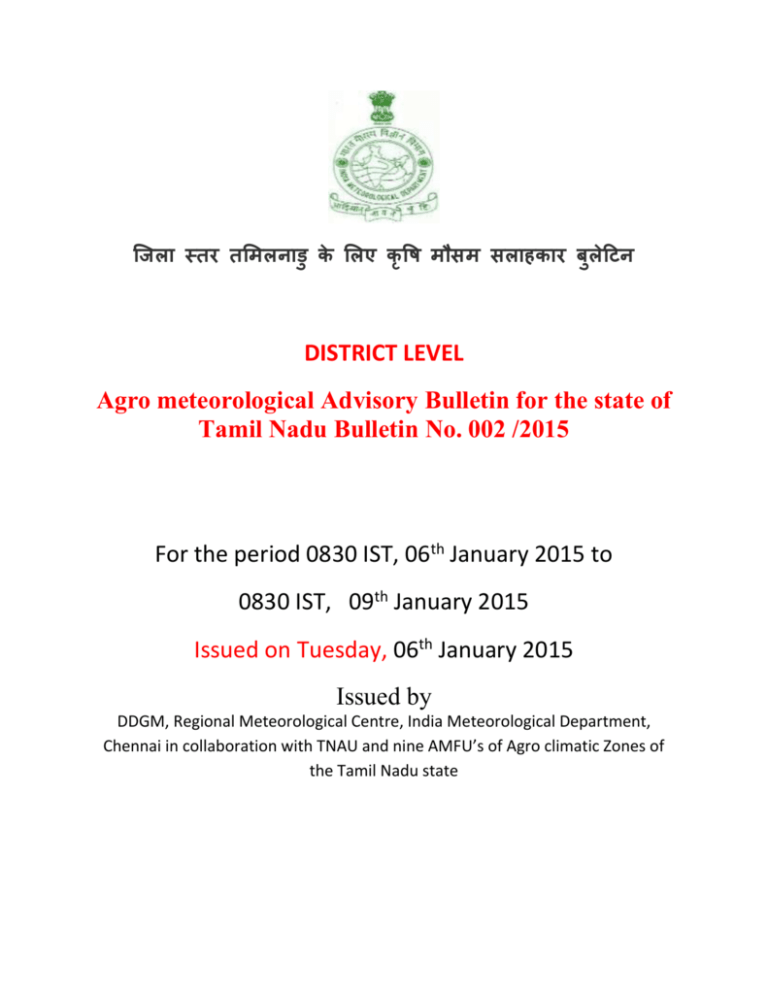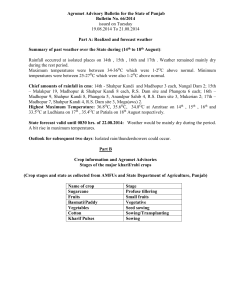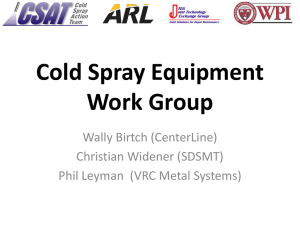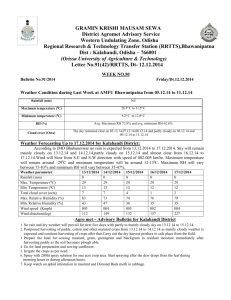Agro climatic zones of the state - Agricultural Meteorology Division
advertisement

जिला स्तर तमिलनाडु के मलए कृषि िौसि सलाहकार बुलेटिन DISTRICT LEVEL Agro meteorological Advisory Bulletin for the state of Tamil Nadu Bulletin No. 002 /2015 For the period 0830 IST, 06th January 2015 to 0830 IST, 09th January 2015 Issued on Tuesday, 06th January 2015 Issued by DDGM, Regional Meteorological Centre, India Meteorological Department, Chennai in collaboration with TNAU and nine AMFU’s of Agro climatic Zones of the Tamil Nadu state Agro climatic zones of the state Sl. No Agro climatic Districts zone Agro met field Unit (AMFU) location 1 Northeastern Kanchipuram, Tiruvallur, Cuddalore Tiruvannamalai, Chennai,Villupuram , zone Vellore Chennai 2 Northwestern Dharmapuri, zone Namakkal 3 Western Zone 4 Cauvery Delta Thanjavur, Nagapattinam, Thiruvarur, Adudurai Karur,Perambalur,Ariyalur and zone Krishnagiri, Salem Erode,Tiuppur and Coimbatore, and Namakkal Coimbatore, Tiruchirapalli. 5 Southern zone Virudhunagar, Toothugudi Tirunelveli and Kovilpatti 6 South Zone Pudukottai,Madurai,Dindigul, Theni, Kannivadi Ramanathapuram and Sivagangai 7 High rainfall Kanyakumari zone Pechiparai 8 Hilly zone Nilgiris Ooty 9 Coastal Zone Karaikal and Pondicherry Karaikal Past Weather Summary for the period 02.01.15 to 05.01.15 State of Tamilnadu & Puducherry for the Temperature: Maximum Temperature of range 27oC – 35oC prevailed over the state. Kodaikanal and Uthagamandalam recorded Maximum temperature range 17oC – 21oC during the period. Minimum temperature of range 19oC - 26oC prevailed over the State. Kodaikanal and Uthagamandalam recorded Minimum temperature of range 04oC - 10oC during the same period. Spatial distribution of Rainfall Spatial distribution of Date Area Widespread (Most places) -- -- Fairly widespread (Many -- -- Scattered (Few Places) 02.01.15 Puducherry Isolated (Isolated Places) 02.01.15 & 03.01.15 Tamilnadu Dry 04.01.15 & 05.01.15 Tamilnadu 03.01.15, 04.01.15 & Puducherry Rainfall places) 05.01.15 Chief Amounts of Rainfall (in cms):02.01.15: Karur paramathi (Karur Dist), Paramathivelur (Namakkal Dist) 7 each, Kollimalai ARG (Namakkal Dist) 5, Sirkali (Nagapattinam Dist) 4, Sendamangalam (Namakkal Dist), Mayanur (Karur Dist), Thathiengrpet (Trichy Dist) 3 each, Namakkal (Namakkal Dist), Devakottai (Sivaganga Dist), Puducherry (Puducherry Dist), Tirupuvanam (Sivaganga Dist), Mangalapuram (Namakkal Dist), Anna University (Chennai Dist), Anna university ARG (Chennai Dist) 2 each, Anaikaranchatram(Kollidam (Nagapattinam Dist), Keeranur (Pudukkottai Dist), Karumandurai ARG (Salem Dist), Dharapuram (Tiruppur Dist), Attur (Salem Dist), Chettikulam (Perambalur Dist), Yercaud (Salem Dist), Vilupuram (Villupuram Dist), Grand Anaicut (Thanjavur Dist), Karur (Karur Dist), Vanur (Villupuram Dist), Panruti (Cuddalore Dist) 1 each. 03.01.15: Nil 04.01.15: Nil 05.01.15: Nil Dist Ensembele Forecast issued on 06.01.2015 valid for next 5 days Districtwise Agromet Advisories Nilgiris Due to low temperature, spray Dasakavya 3% once in 10 days to control blister blight in Tea crop As there is forecast for no rainfall, irrigation has to be given as per the requirement of the crop Due to dry weather, farmers are advised to spray systemic and contact fungicides once in 7 days interval to control late blight in potato Due to low night temperatures in the past 4 days, necessary measures like mulching may be adopted to prevent frost damage in crops To control pest and diseases, farmers are advised to give protective sprays for when there is no rain. Due to high day temperature, spray Zineb + hexaconazole combination @ 2g /l to control Alternaria blight in carrot. Puducherry To manage the leaf folder / stem borer / gall midge in rice ; spray Chlorpyriphos 20 EC @ 500 ml / acre or Phosalone @ 600 ml /acre or profenophos 400 ml /acre To manage the gall midge / BPH in rice ; spray Chlorpyriphos 20 EC @ 500 ml / acre or Phosalone @ 600 ml /acre To manage BLB in rice; as a prophylactic measure spray 20 % cow dung extract ( 40kg fresh cow dung in 100 litres of water; soaked overnight and the filtered extract to be made up to 200 litres per acre) or 0.2 % Pseudomonas fluorescence extract ( 2 ml or gm per litre) or 3 % neem oil + surfactant. Repeat the spray once again after fifteen days. In case of incidence of BLB, spray copper hydroxide 2 g per litre in fifteen days interval for two times. Karaikal To manage false smut; spray Propiconazole 25 EC @ 200 ml/ac or Copper hydroxide @ 500 g / acre at booting stage & at fifty percent flowering stage during evening hours. To manage the leaf folder / stem borer / gall midge in rice ; spray Chlorpyriphos 20 EC @ 500 ml / acre or Phosalone @ 600 ml /acre or profenophos 400 ml /acre To manage the gall midge / BPH in rice ; spray Chlorpyriphos 20 EC @ 500 ml / acre or Phosalone @ 600 ml /acre To manage BLB in rice; as a prophylactic measure spray 20 % cow dung extract ( 40kg fresh cow dung in 100 litres of water; soaked overnight and the filtered extract to be made up to 200 litres per acre) or 0.2 % Pseudomonas fluorescence extract ( 2 ml or gm per litre) or 3 % neem oil + surfactant. Repeat the spray once again after fifteen days. In case of incidence of BLB, spray copper hydroxide 2 g per litre in fifteen days interval for two times. Coimbatore Blocks Sugar cane Banana Turmeric Vegetables Rice Cotton Thondamuthur 9 months 7 months RD V NC B Karamadai 11 months 9 months RD V NC B Sulur 7 months 9 months RD V NC B Sultanpet 9 months 7 months RD V NC B Pollachi 9 months 10 months RD V F B P.N Palayam 5 months 10 months RD V NC B Kinathukadavu NC NC RD V NC B Annur NC 8 months RD V NC B Madukarai NC 6 months RD V NC B Annaimalai 6 months 3 months RD V F B NC-No Crop,RD – Rhizome Development; V- Vegetative;F-Flowering; B –Boll bursting Agro Advisory By utilizing cool and dry weather cotton stocks must be pulled out and burned otherwise ploughed in situ by using rotavator to avoid the multiplication of stem weevil. By utilizing cool and dry weather, annual pruning to pomegranate may be done. Past season shoot, diseased, dried branches are pruned. After pruning manure it and irrigate it. Since no rainfall is expected top dressing to rice may be done by using 35 kg urea and 17 kg potash. Prevailing cool weather condition may be favorable for leaf spot disease in turmeric therefore the farmers are requested to monitor the crop and if necessary spray mancozeb 1 kg/ha or carbendazim 0.5 kg/ ha. SMS advisory By utilizing cool and dry weather prune the diseased and dried branches to pomegranate. After pruning manure it and irrigate it. Erode Taluks Sugarcane Banana Turmeric Rice Tapioca Cotton Ammapet 10 months One month RD M H&V B Bhavani 7 months One month RD M H&V B Erode 6 months One month RD M H&V B Perundurai 6 months One month RD M H&V B Sathyamangalam 9 months One month RD M H&V B Nambiyur 6 months One month RD M H&V B Gobichettipalayam 5 months One month RD M H&V B RD – Rhizome Development, M- Milky stage H&V- Harvest and Vegetative; B- Boll bursting Agro Advisory By utilizing cool and dry weather cotton stocks must be pulled out and burned otherwise ploughed in situ by using rotavater to avoid the multiplication of stem weevil. By utilizing cool and dry weather, annual pruning to pomegranate may be done. Past season shoot, diseased, dried branches are pruned. After pruning manure it and irrigate it. Since no rainfall is expected top dressing to rice may be done by using 35 kg urea and 17 kg potash. Since no rainfall is expected in groundnut may be earthing up may be done and Gypsum application 400 kg/ ha. Prevailing cool weather condition may be favorable for leaf spot disease in turmeric therefore the farmers are requested to monitor the crop and if necessary spray mancozeb 1 kg/ha or carbendazim 0.5 kg/ ha. SMS advisory By utilizing cool and dry weather prune the diseased and dried branches to pomegranate. After pruning manure it and irrigate it. Tiruppur Blocks Tapioca Sugarcane Banana Vegetables Maize Rice Cotton Avinashi H&V 10 months 6 months V T NC NC Kankayam H&V NC NC V T NC NC Madathukulam H&V NC NC V T F B Gudimangalam H&V 6 months 8 months V T F B Palladam H&V NC NC V T NC NC Dharapuram H&V 5 months 4 months V T F Udumalpet H&V 7 months NC T F H&V- Harvest and vegetative; NC-No Crop; V- Vegetative; T- Tasseling; F- Flowering; Boll bursting B B- Agro Advisory By utilizing cool and dry weather cotton stocks must be pulled out and burned otherwise ploughed in situ by using rotavater to avoid the multiplication of stem weevil. By utilizing cool and dry weather, annual pruning to pomegranate may be done. Past season shoot, diseased, dried branches are pruned. After pruning manure it and irrigate it. Since no rainfall is expected top dressing to rice may be done by using 35 kg urea and 17 kg potash. Since no rainfall is expected in groundnut may be earthing up may be done and Gypsum application 400 kg/ ha. Prevailing cool weather condition may be favorable for leaf spot disease in turmeric therefore the farmers are requested to monitor the crop and if necessary spray mancozeb 1 kg/ha or carbendazim 0.5 kg/ ha. SMS advisory By utilizing cool and dry weather prune the diseased and dried branches to pomegranate. After pruning manure it and irrigate it. Chennai Livestock : 1. Young calves, lambs and kids should be protected from chillness by way of providing curtain in sides of animal shed during night time. 2. Cattle, sheep and goats are allowed to graze after dew dried off to avoid fluke infestation. 3. Calves above 3 months and sheep and goat above 2 months should be vaccinated against Foot and Mouth disease 4. Sheep and Goats should be dewormed by using broad spectrum antihelmintics. Kanchipuram Livestock : 1. Young calves, lambs and kids should be protected from chillness by way of providing curtain in sides of animal shed during night time. 2. Cattle, sheep and goats are allowed to graze after dew dried off to avoid fluke infestation. 3. Sheep and Goats should be dewormed by using broad spectrum antihelmintics. 4. In case of poultry, farmers are advised to provide clean drinking water to avoid E.coli infection. 5. Poultry farmers are advised to protect their feed ingredients from rain and dampness to avoid aflatoxin poisoning. Thiruvallur Livestock : 1. Young calves, lambs and kids should be protected from chillness by way of providing curtain in sides of animal shed during night time. 2. Cattle, sheep and goats are allowed to graze after dew dried off to avoid fluke infestation. 3. Sheep and Goats should be dewormed by using broad spectrum antihelmintics. 4. In case of poultry, farmers are advised to provide clean drinking water to avoid E.coli infection. 5. Poultry farmers are advised to protect their feed ingredients from rain and dampness to avoid aflatoxin poisoning. Vellore Livestock : 1. Young calves, lambs and kids should be protected from chillness by way of providing curtain in sides of animal shed during night time. 2. Cattle, sheep and goats are allowed to graze after dew dried off to avoid fluke infestation. 3. Sheep and Goats should be dewormed by using broad spectrum antihelmintics. 4. In case of poultry, farmers are advised to provide clean drinking water to avoid E.coli infection. 5. Poultry farmers are advised to protect their feed ingredients from rain and dampness to avoid aflatoxin poisoning. Thiruvannamalai Livestock : Young calves, lambs and kids should be protected from chillness by way of providing curtain in sides of animal shed during night time. 2. Cattle, sheep and goats are allowed to graze after dew dried off to avoid fluke infestation. 3. Avoid stagnation of rain water nearby animal shed to avoid multiplication of vectors 4. Sheep and Goats should be dewormed by using broad spectrum antihelmintics. 1. Cuddalore Livestock : 1. Young calves, lambs and kids should be protected from chillness by way of providing curtain in sides of animal shed during night time. 2. Cattle, sheep and goats are allowed to graze after dew dried off to avoid fluke infestation. 3. Sheep and Goats should be dewormed by using broad spectrum antihelmintics. 4. In case of poultry, farmers are advised to provide clean drinking water to avoid E.coli infection 5. Poultry farmers are advised to protect their feed ingredients from rain and dampness to avoid aflatoxin poisoning. Villupuram Livestock : 1. Young calves, lambs and kids should be protected from chillness by way of providing curtain in sides of animal shed during night time. 2. Cattle, sheep and goats are allowed to graze after dew dried off to avoid fluke infestation. 3. Sheep and Goats should be dewormed by using broad spectrum antihelmintics. 6. In case of poultry, farmers are advised to provide clean drinking water to avoid E.coli infection Chennai, Tiruvallur, Kanchipuram, Cuddalore, Villupuram, Vellore & Thiruvannamalai Agriculture : 1. Paddy and groundnut crops are under flowering stage. 2. Spraying of edifenphos @ 750 ml/ha at 30, 45 and 60 DAT was effective for the management of blast, sheath rot and brown spot. 3. Spraying of carbendazim 50 WP 250 g/ha plus mancozeb 1000 g/ha was effective in reducing rust and tikka leaf spot of groundnut Virudhunagar Crop/ Farming system Sorghum Stage / Activities Advisories Maturity stage As dry weather is expected in the coming days harvest the sorghum crop when the grains turn yellow. Plough the field immediately after harvest in order to destroy the pupae of stem borer. Maize Maturity stage As dry weather is expected in the coming days harvest the cobs, dry under sun and thresh the dry cobs by using mechanical thresher. Clean the seeds by winnowing and store the dry grains in gunny bags. Cotton Flowering The prevailing weather condition is conducive for the incidence of boll stage worm in cotton varieties. The American boll worm feeds on the bolls by forming circular bore holes and inserting its head alone into the bolls. For monitoring the adults set up light and pheromone traps. Release Trichogramma egg parasitoid at 6.25 cc/ ha to control the pest. When damage exceeds economic threshold level, spray phosalone 35 EC 2.5 l/ ha or quinalphos 25 EC 2 l/ ha. Use 1000 litre of spray fluid/ha. Chilli Flowering Since flower formation is more at this stage, for meeting the crop stage demand apply nitrogen 25 kg/ ha (urea 55 kg/ ha) and do earthing up. Unfavourable soil and environmental factors, hormonal deficiency and pest and disease incidence are responsible for flower dropping in chilli. For improving flower retention and pod formation spray NAA 10 ppm (10 mg/ l) and triacontanol 1.25 mg/ l on 90 days after planting. In the prevailing weather condition incidence of mite is noticed in chilli. Spray dicofol 2.5 ml/ l or wettable sulphur 6 g/ l for controlling this pest. SMS: Rain- January 8& 9th (mm): 3, 1 mm, respectively. Harvest sorghum& plough the field immediately after harvest to destroy stem borer pupae. Thoothukudi Crop/ Farming system Rice Sorghum Stage / Activities Advisories Ripening For the rice crop at ripening stage irrigate at 5 cm depth one day after stage disappearance of ponded water. Maturity stage As dry weather is expected in the coming days harvest the sorghum crop when the grains turn yellow. Plough the field immediately after harvest in order to destroy the pupae of stem borer. Maize Maturity stage As dry weather is expected in the coming days harvest the cobs, dry under sun and thresh the dry cobs by using mechanical thresher. Clean the seeds by winnowing and store the dry grains in gunny bags. Cotton Flowering The prevailing weather condition is conducive for the incidence of boll stage worm in cotton varieties. The American boll worm feeds on the bolls by forming circular bore holes and inserting its head alone into the bolls. For monitoring the adults set up light and pheromone traps. Release Trichogramma egg parasitoid at 6.25 cc/ ha to control the pest. When damage exceeds economic threshold level, spray phosalone 35 EC 2.5 l/ ha or quinalphos 25 EC 2 l/ ha. Use 1000 litre of spray fluid/ha. Chilli Flowering Since flower formation is more at this stage, for meeting the crop demand stage apply nitrogen 25 kg/ ha (urea 55 kg/ ha) and do earthing up. Unfavourable soil and environmental factors, hormonal deficiency and pest and disease incidence are responsible for flower dropping in chilli. For improving flower retention and pod formation spray NAA 10 ppm (10 mg/ l) and triacontanol 1.25 mg/ l on 90 days after planting. In the prevailing weather condition incidence of mite is noticed in chilli. Spray dicofol 2.5 ml/ l or wettable sulphur 6 g/ l for controlling this pest. SMS: Rain- 6& 7th January 2015 (mm): 5& 4 mm, respectively. Harvest sorghum& plough the field immediately after harvest to destroy stem borer pupae. Tirunelveli Crop/ Farming system Rice Stage / Activities Advisories Ripening stage For the rice crop at ripening stage irrigate at 5 cm depth one day after disappearance of ponded water. Cotton, Chilli Flowering As light rainfall is expected in the coming days provide adequate stage drainage in the field. Pearl millet, Grain filling Sunflower stage Cotton Flowering The prevailing weather condition is conducive for the incidence of boll stage worm in cotton varieties. The American boll worm feeds on the bolls by forming circular bore holes and inserting its head alone into the bolls. For monitoring the adults set up light and pheromone traps. Release Trichogramma egg parasitoid at 6.25 cc/ ha to control the pest. When damage exceeds economic threshold level, spray phosalone 35 EC 2.5 l/ ha or quinalphos 25 EC 2 l/ ha. Use 1000 litre of spray fluid/ha. Chilli Flowering Since flower formation is more at this stage, for meeting the crop stage demand apply nitrogen 25 kg/ ha (urea 55 kg/ ha) and do earthing up. Unfavourable soil and environmental factors, hormonal deficiency and pest and disease incidence are responsible for flower dropping in chilli. For improving flower retention and pod formation spray NAA 10 ppm (10 mg/ l) and triacontanol 1.25 mg/ l on 90 days after planting. In the prevailing weather condition incidence of mite is noticed in chilli. Spray dicofol 2.5 ml/ l or wettable sulphur 6 g/ l for controlling this pest. SMS: Chilli- improve flower retention- spray NAA 10 mg/ l & triacontanol 1.25 mg/ l. Salem, Namakkal, Dharmapuri & Krishnagiri 1. With the chance of formation of mild mist in the upcoming days feed intake in birds will be normal to slightly above normal. To protect the birds form mist during early morning, raise the curtains to about 3 feet height on the sides of the poultry houses. Further, test maize and sunflower meal for occurrence of mycotoxin before use. A) Special Agroadvisory from Krishi Vigyan Kendra: 2. As this season is favorable for the cultivation of green gram and black gram, farmers can choose highbred, short term and disease resistant verities. Yellow mosaic disease resistant black gram verities such as Co-6, Vamban -5, 6,7 and green gram verities such as Co- 7, 8, Vamban- 2, 3 can be cultivated. =========================================================================






